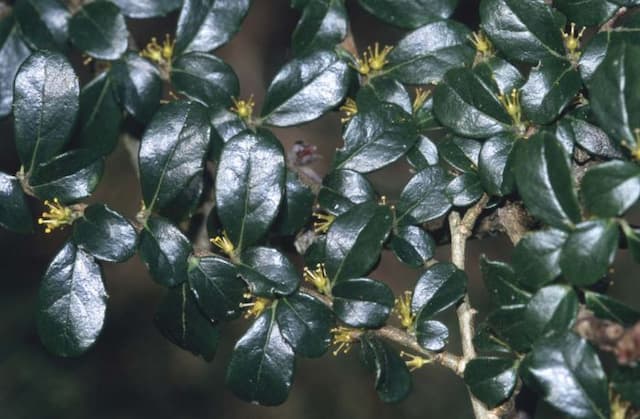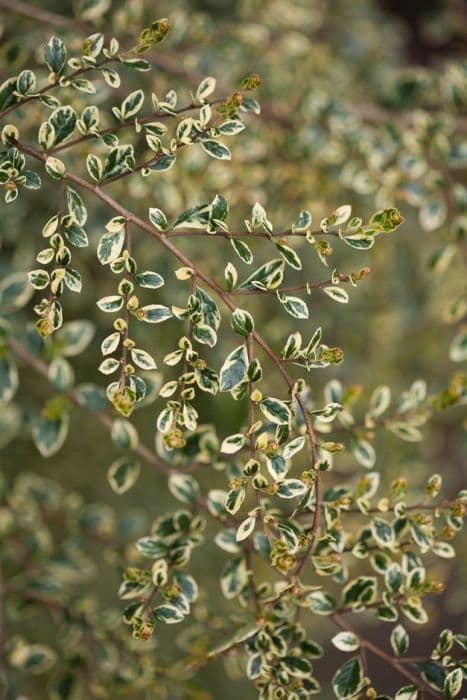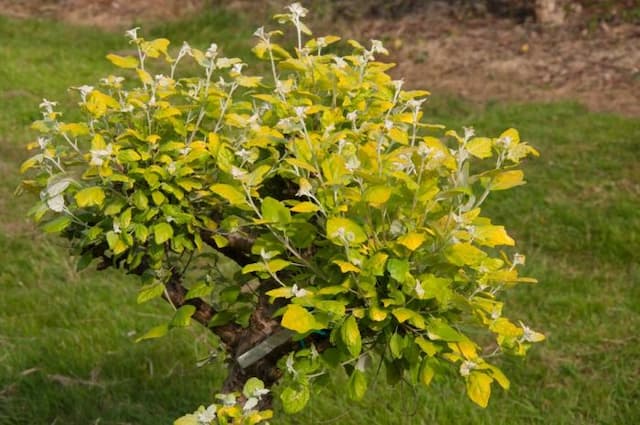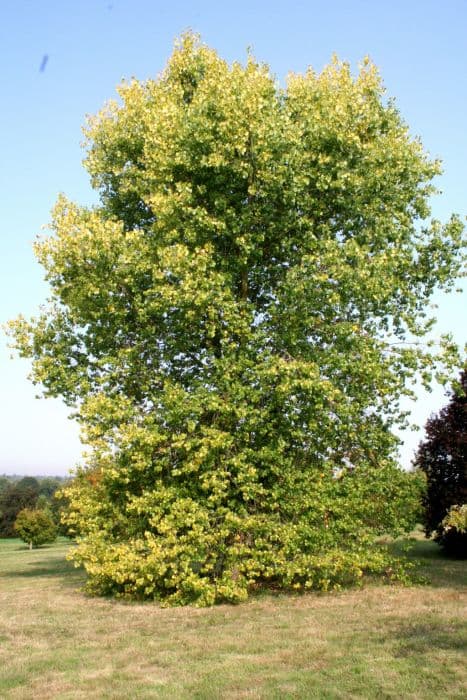Weeping Purple Willow Salix purpurea 'Pendula'

ABOUT
The plant in discussion is commonly known as the Weeping Willow. It is recognizable by its striking appearance, featuring long, slender branches that cascade downward, creating a graceful, weeping effect. The leaves of the Weeping Willow are narrow and elongated, with a lush green color that can add a lively texture to the landscape. During the blooming season, the plant shows off catkins, which are cylindrical flower clusters that can range in color from silver to green and sometimes have a hint of purple. The supportive trunk of the Weeping Willow tends to be gnarled and adds to the overall dramatic visual impact of the plant, providing a strong, yet elegant, presence.
About this plant
 Names
NamesFamily
Salicaceae
Synonyms
Weeping Purple Willow, Purple Osier Willow, Purple Willow
Common names
Salix purpurea 'Pendula'.
 Characteristics
CharacteristicsLife cycle
Perennials
Foliage type
Deciduous
Color of leaves
Green
Flower color
Yellow
Height
4-6 feet (1.2-1.8 meters)
Spread
4-8 feet (1.2-2.4 meters)
Plant type
Tree
Hardiness zones
4
Native area
Europe
Benefits
 General Benefits
General Benefits- Aesthetic Appeal: The Weeping Willow has a unique, graceful form that adds visual interest to landscapes.
- Shade Provider: Its canopy creates a cool, shaded area underneath, which can be beneficial during hot summers.
- Habitat for Wildlife: Birds and other wildlife often use the tree for nesting and as a source of food.
- Erosion Control: The dense root system of the Weeping Willow can help stabilize soil and prevent erosion along riverbanks or water bodies.
- Growth Rate: It is a fast-growing tree, which means it can quickly provide the benefits of a mature tree.
- Adaptability: The Weeping Willow can thrive in a range of soil types and conditions, though it prefers moist settings.
- Windbreak: When planted in groups, these trees can act as a windbreak, protecting areas from strong winds.
- Seasonal Interest: Throughout the year, its changing foliage offers seasonal interest, from green leaves in spring/summer to yellow in the fall.
- Sound Barrier: The dense branches and foliage can help reduce noise pollution, creating a quieter environment.
- Streambank Stabilization: Particularly useful in riparian restoration projects to help stabilize streambanks and restore natural habitats.
 Medical Properties
Medical PropertiesThis plant is not used for medical purposes.
 Air-purifying Qualities
Air-purifying QualitiesThis plant is not specifically known for air purifying qualities.
 Other Uses
Other Uses- Weeping willow branches can be used in floristry for creating dramatic and cascading floral arrangements due to their long, graceful stems.
- The flexible twigs of the weeping willow can be woven into rustic furniture such as chairs or decorative baskets, showcasing the versatility of willow wood.
- Weeping willow can be planted for soil erosion control along riverbanks because their root systems help to consolidate the soil.
- The wood of weeping willow is sometimes used for making whistles or flutes, especially by artisans who specialize in crafting traditional wooden instruments.
- Weeping willow is often used as a natural privacy screen or living fence due to its dense foliage and fast growth rate.
- In bonsai art, weeping willow can be trained to create miniature landscapes, capitalizing on its naturally drooping form and fine texture.
- Weeping willow twigs may be used in the craft of willow sculpture to create intricate and expressive outdoor art pieces.
- The wood of the weeping willow is sometimes utilized in the creation of cricket bats because of its tough yet lightweight properties.
- Due to its distinctive appearance, the weeping willow is commonly employed as a focal point in garden design and landscape architecture projects.
- Weeping willows are occasionally planted in cemeteries and memorial gardens, symbolizing mourning and remembrance with their somber, drooping branches.
Interesting Facts
 Feng Shui
Feng ShuiThe Weeping Willow is not used in Feng Shui practice.
 Zodiac Sign Compitability
Zodiac Sign CompitabilityThe Weeping Willow is not used in astrology practice.
 Plant Symbolism
Plant Symbolism- Flexibility: Salix purpurea 'Pendula', known as Weeping Willow, has a flexible trunk and branches that bend without breaking. It symbolizes the ability to adapt to life's challenges without losing strength.
- Sorrow: The drooping branches of the Weeping Willow are often seen as a universal emblem of sorrow, expressing themes of mourning and the beauty found in sadness.
- Healing: Historically, willow bark has been used for its medicinal properties, and the tree is symbolic of healing and recovery from emotional or physical pain.
- Growth and Renewal: Willows are fast-growing trees that can regenerate from a single fallen branch, representing the themes of personal growth, renewal, and the cyclical nature of life.
- Protection: In some folklore, the Weeping Willow is believed to ward off evil and protect those who take shelter under its canopy, symbolizing safety and sanctuary.
- Poetry and Art: The Weeping Willow's distinctive appearance is often associated with romantic poetry and art, symbolizing the deep emotions and creativity that inspire artists.
- Freedom: The tree's movement in the wind gives off a sense of freedom and ease, with its branches moving gracefully, reminding us to let go of our burdens and be free.
 Water
WaterThe Weeping Willow should be watered deeply, ensuring that the soil is moist but not soggy. Newly planted trees require watering twice a week, with each watering consisting of about 10-15 gallons, depending on the size of the tree and the weather conditions. Once established, watering can be reduced to once a week during dry periods, with a similar amount of water. It's important not to overwater, as Weeping Willows are susceptible to root rot, especially in poorly-drained soils.
 Light
LightWeeping Willows thrive best in full sunlight, which means they should receive at least six hours of direct sunlight daily. An ideal spot would be an open area away from buildings or shade from other trees, where the plant can receive unfiltered sunlight throughout the day.
 Temperature
TemperatureWeeping Willows fare well in a wide range of temperatures but prefer the zone of 4 to 8 in the United States, which corresponds to a minimum temperature range of -30°F to 20°F and maximum temperatures that do not usually exceed 90°F. The ideal growing conditions for a Weeping Willow include moderate temperatures that typically range between 50°F and 80°F.
 Pruning
PruningPruning a Weeping Willow is essential to remove dead or damaged branches, to shape the tree, and to maintain its health. It should be done in late winter or early spring while the tree is dormant, and before the sap begins to flow. Prune as little as necessary to maintain the desired shape and remove only what is needed, typically no more than a quarter of the canopy at a time.
 Cleaning
CleaningAs needed
 Soil
SoilThe Weeping Purple Willow thrives best in moist, well-drained loamy soil. A mix containing peat, loamy garden soil, and sand in equal parts creates an ideal environment for the roots to spread and access nutrients. For optimal growth, maintaining a soil pH of around 6.0 to 7.5 is suitable for this willow variety.
 Repotting
RepottingWeeping Purple Willows are typically landscape plants and are not commonly repotted. If grown in a container, young willows may need repotting every 2-3 years to accommodate rapid growth, but mature plants are better suited to open ground where they require no repotting.
 Humidity & Misting
Humidity & MistingWeeping Purple Willows prefer outdoor conditions where they can receive natural humidity. Optimal humidity levels are those found outside, mimicking the tree's natural environment, without the need for specific indoor humidity adjustments.
 Suitable locations
Suitable locationsIndoor
Weeping Purple Willow rarely grown indoors; needs ample space, bright light.
Outdoor
Plant in full sun, ensure ample water, protect from strong winds.
Hardiness zone
4-8 USDA
 Life cycle
Life cycleSalix purpurea 'Pendula', commonly known as the Weeping Purple Willow, begins its life cycle with seed germination, typically occurring in moist soils near bodies of water. As the seedling emerges, it grows rapidly, establishing a strong root system and a trunk that soon starts to weep or droop. Through the juvenile stage, it develops elongated branches and narrow, lance-shaped leaves, which take on a purple or blue-green hue. The plant reaches maturity within a few years, producing yellow catkins in early spring that are pollinated by insects, after which seeds develop and disperse to start new life cycles. Throughout its lifespan, which can be several decades long, the Weeping Purple Willow requires ample water and often undergoes seasonal pruning to maintain its shape and health. As the plant ages, it may experience reduced vigor and become susceptible to pests and diseases before eventually entering senescence and dying.
 Propogation
PropogationPropogation time
Early Spring
The Weeping Purple Willow (Salix purpurea 'Pendula') is typically propagated by taking softwood cuttings in late spring or early summer when the plant is actively growing. Cuttings of about 6 to 8 inches (15 to 20 centimeters) in length are taken from healthy branches, making sure that each cutting has several leaf nodes. The lower leaves are removed, and the cut end is dipped in rooting hormone before being planted in a well-draining soil mix. These cuttings should then be placed in a sheltered, humid environment to prevent them from drying out while they form roots, a process that can take several weeks. Once rooted, the cuttings can be transplanted into individual pots before being moved to their permanent location.









